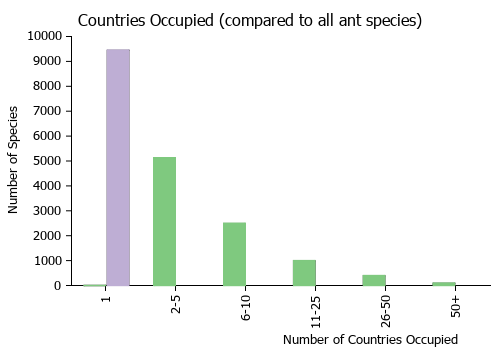Camponotus ephippium
| Camponotus ephippium | |
|---|---|

| |
| Scientific classification | |
| Kingdom: | Animalia |
| Phylum: | Arthropoda |
| Class: | Insecta |
| Order: | Hymenoptera |
| Family: | Formicidae |
| Subfamily: | Formicinae |
| Tribe: | Camponotini |
| Genus: | Camponotus |
| Species: | C. ephippium |
| Binomial name | |
| Camponotus ephippium (Smith, F., 1858) | |
| Subspecies | |
| |
Photo Gallery
Identification
Keys including this Species
- Key to Australian Camponotus species
- Key to Australian Camponotus majors of the southwestern Botanical Province
- Key to Australian Camponotus minors of the southwestern Botanical Province
Distribution
Latitudinal Distribution Pattern
Latitudinal Range: -18.98701° to -36.61666667°.
| North Temperate |
North Subtropical |
Tropical | South Subtropical |
South Temperate |
- Source: AntMaps
Distribution based on Regional Taxon Lists
Australasian Region: Australia (type locality).
Distribution based on AntMaps
Distribution based on AntWeb specimens
Check data from AntWeb
Countries Occupied
| Number of countries occupied by this species based on AntWiki Regional Taxon Lists. In general, fewer countries occupied indicates a narrower range, while more countries indicates a more widespread species. |

|
Estimated Abundance
| Relative abundance based on number of AntMaps records per species (this species within the purple bar). Fewer records (to the left) indicates a less abundant/encountered species while more records (to the right) indicates more abundant/encountered species. |

|
Biology
Castes
Nomenclature
The following information is derived from Barry Bolton's Online Catalogue of the Ants of the World.
- ephippium. Formica ephippium Smith, F. 1858b: 39 (w.) AUSTRALIA (South Australia).
- Type-material: holotype (?) worker.
- [Note: no indication of number of specimens is given.]
- Type-locality: Australia: South Australia, Adelaide (no collector’s name).
- Type-depository: BMNH.
- Wheeler, G.C. & Wheeler, J. 1968: 218 (l.).
- Combination in Camponotus: Roger, 1863b: 4;
- combination in C. (Myrmocamelus): Forel, 1914a: 270;
- combination in C. (Myrmophyma): Emery, 1920b: 257; Santschi, 1928e: 481.
- Status as species: Mayr, 1863: 414; Roger, 1863b: 4; Mayr, 1876: 59 (in key); Emery, 1887a: 211; Dalla Torre, 1893: 229; Emery, 1896d: 373 (in list); Forel, 1902h: 503; Forel, 1907h: 303; Crawley, 1915a: 136; Emery, 1925b: 111; Taylor & Brown, 1985: 113; Taylor, 1987a: 12; Bolton, 1995b: 97; McArthur, 2007a: 316; Heterick, 2009: 65; McArthur, 2010: 44; McArthur, 2014: 104.
- Distribution: Australia.
- Current subspecies: nominal plus narses.
Type Material
- Formica ephippium Smith, 1858: Syntype, 2 workers, Adelaide, South Australia, Australia, The Natural History Museum.
Unless otherwise noted the text for the remainder of this section is reported from the publication that includes the original description.
Description
Worker. Length 3 lines (= 6 mm) Black: the pro- and mesothorax ferruginous above. Head oblong-quadrate, slightly narrowed towards the mouth; the eyes placed high on t he sides of the head; the antennae and mandibles ferruginous; the scape more or less fuscous; the clypeus with a central longitudinal carina; the mandibles serrated on their inner edge, with one or two stouter teeth at the apex. Thorax rounded in front and narrowed behind, the metathorax (= propodeum) sometimes slightly ferruginous; legs elongate, the apical joints of the tarsi ferruginous. Abdomen small, ovate, covered with short pale yellow silky pubescence, interspersed with longer pale hairs; the head and thorax have also some scattered pale hairs; the scale of the peduncle subovate.
Hab. Adelaide. (Coll. F. Smith)
References
- Bolton, B. 1995b. A new general catalogue of the ants of the world. Cambridge, Mass.: Harvard University Press, 504 pp. (page 97, catalogue)
- Emery, C. 1920b. Le genre Camponotus Mayr. Nouvel essai de la subdivision en sous-genres. Rev. Zool. Afr. (Bruss.) 8: 229-260 (page 257, combination in C. (Myrmophyma))
- Forel, A. 1914a. Le genre Camponotus Mayr et les genres voisins. Rev. Suisse Zool. 22: 257-276 (page 270, combination in C. (Myrmocamelus))
- Gonçalves‐Neto, S., Azevedo‐Silva, M., Lemos, A.S.M., Souza, A.P., Oliveira, P.S. 2021, Microsatellites for the Neotropical ant, Camponotus leydigi (Hymenoptera: Formicidae). Entomological Science 24: 79-84 (doi:10.1111/ens.12454).
- Heterick, B.E. 2021. A guide to the ants of Western Australia. Part I: Systematics. Records of the Western Australian Museum, Supplement 86, 1-245 (doi:10.18195/issn.0313-122x.86.2021.001-245).
- Heterick, B.E. 2022. A guide to the ants of Western Australia. Part II: Distribution and biology. Records of the Western Australian Museum, supplement 86: 247-510 (doi:10.18195/issn.0313-122x.86.2022.247-510).
- Roger, J. 1863b. Verzeichniss der Formiciden-Gattungen und Arten. Berl. Entomol. Z. 7(B Beilage: 1-65 (page 4, combination in Camponotus)
- Santschi, F. 1928e. Nouvelles fourmis d'Australie. Bull. Soc. Vaudoise Sci. Nat. 56: 465-483 (page 481, combination in C. (Myrmophyma))
- Smith, F. 1858b. Catalogue of hymenopterous insects in the collection of the British Museum. Part VI. Formicidae. London: British Museum, 216 pp. (page 39, worker described)
- Wheeler, G. C.; Wheeler, J. 1968a. The ant larvae of the subfamily Formicinae (Hymenoptera: Formicidae): supplement. Ann. Entomol. Soc. Am. 61: 205-222 (page 218, larva described)
References based on Global Ant Biodiversity Informatics
- Andersen A. N., B. D. Hoffman, and J. Somes. 2003. Ants as indicators of minesite restoration: community recovery at one of eight rehabilitation sites in central Queensland. Ecological Management and Restoration 4: 12-19.
- Heterick B. E. 2009. A guide to the ants of south-western Australia. Records of the Western Australian Museum Supplement 76: 1-206.



